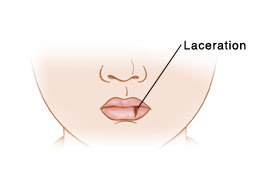A laceration is a cut through the skin. When the cut is on the outside of the lip, it may be closed with stitches. Cuts inside the mouth, including the tongue, may be stitched or left open, depending on the size. When stitches are used in the mouth, they are usually the kind that dissolve on their own.
A tetanus shot may be given if you are not current on this vaccine and the object that caused the cut may lead to tetanus.
Home care
-
Follow all instructions for taking medicines prescribed.
-
Your healthcare provider may prescribe an antibiotic to prevent infection. Don't stop taking this medicine until you have finished it all, even if you feel better.
-
The healthcare provider may prescribe medicines for pain. Take these exactly as directed.
-
-
Follow the healthcare provider’s instructions on how to care for the cut.
-
Wash your hands with soap and clean, running water before and after caring for your cut. This helps prevent infection.
-
If the cut is inside your mouth, clean the wound by rinsing your mouth after each meal and at bedtime with water. You may also be prescribed chlorhexidine mouthwash to swish and spit to keep the wound clean.
-
Eat soft foods. Mouth wounds can cause pain when chewing. If needed, use an over-the-counter numbing solution for pain relief, such as one for babies who are teething. Put this directly to the wound with a cotton-tip swab or your clean finger.
-
If the wound is bandaged, leave the original bandage in place for 24 hours. Replace it if it becomes wet or dirty. After 24 hours, change it once a day or as directed.
-
If the cut is on the outside of the lip and stitches were used, shower as usual after the first 24 hours, but don't put your head underwater or swim until the stitches are removed. After removing the bandage, wash the area with soap and water. Use a wet cotton swab to loosen and remove any blood or crust that forms. After cleaning, keep the wound clean and dry. Talk with your healthcare provider before applying any antibiotic ointment to the wound. You may apply an adhesive bandage or leave the wound open. Unless told otherwise, stitches on the inside of the mouth will likely dissolve on their own.
-
You should keep healing wounds out of prolonged direct sunlight. This will lessen scarring.
-
Even with correct treatment, a wound infection may sometimes occur. Check the wound daily for signs of infection listed below.
Follow-up care
Follow up with your healthcare provider as directed. If you have stitches that don't dissolve on their own, return as directed to have them removed.
When to get medical advice
Call your healthcare provider right away if any of these occur:
-
Wound bleeding that's not controlled by direct pressure
-
Signs of infection. These include increasing pain in the wound, increasing wound redness or swelling, or pus or bad odor coming from the wound.
-
Fever of 100.4°F (38.ºC) or higher, or as directed by your healthcare provider
-
Chills
-
Stitches come apart or fall out
-
Wound edges reopen
-
Wound changes color
-
Numbness around the wound


